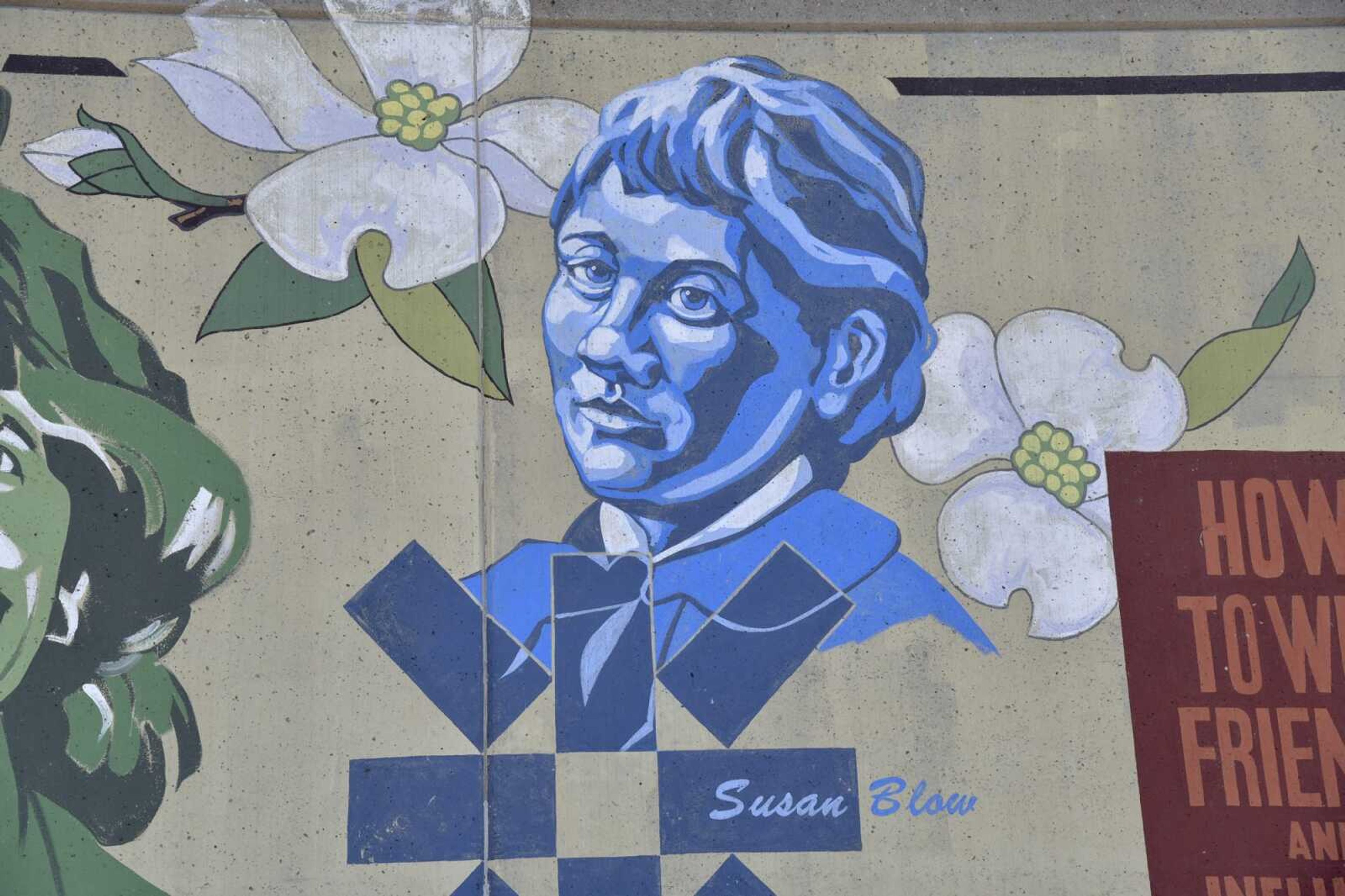Missouri bicentennial: Kindergarten's 'mother,' Susan Blow
The likeness of Susan E. Blow (1843-1916), sometimes called the "Mother of the Public Kindergarten Movement," is on one of the panels of famous Missourians found today at the Cape Girardeau waterfront. A native Missourian, Blow was born to a wealthy family whose Mississippi riverfront home burned to the ground in St. Louis' great fire of 1849. Not long after, a deadly cholera epidemic swept through the city, killing an estimated 7,000 people. ...
This is the ninth in a series of articles with Kellerman Foundation for Historic Preservation board chairman Frank Nickell, an emeritus faculty member of Southeast Missouri State University, commenting on Show Me State history on the 200th anniversary of Missouri being received as America's 24th state in 1821.
The likeness of Susan E. Blow (1843-1916), sometimes called the "Mother of the Public Kindergarten Movement," is on one of the panels of famous Missourians found today at the Cape Girardeau waterfront.
A native Missourian, Blow was born to a wealthy family whose Mississippi riverfront home burned to the ground in St. Louis' great fire of 1849.
Not long after, a deadly cholera epidemic swept through the city, killing an estimated 7,000 people.
Many of the survivors of the twin calamities of fire and deadly illness resettled away from downtown to outlying areas.
The Blow family moved to Carondelet, a French settlement 5 miles downriver.
Blow's father, Henry Taylor Blow, made a fortune in the lead industry and wanted his daughter to have every chance to succeed in society.
It was a time in which school opportunities were not usually offered to girls and many children spent their days working on farms or in factories.
In a letter dated 1857, the elder Blow wrote, "Sue must have the best advantage in education."
Blow had governesses at home and attended private schools in New Orleans and New York City.
At age 18, Blow's schooling was cut short by the Civil War.
Returning to the Show Me State, Blow studied on her own using her father's extensive library.
In 1869, as a young woman in her middle 20s, Blow served as her father's secretary after his appointment as U.S. ambassador to Brazil.
Later, Blow traveled to Germany and had an experience there that gave the Missourian her life's work.
She observed German classrooms that were inspired by the work of Friedrich Froebel, whose early education efforts involved the youngest of children learning important language, math and science skills by playing with objects such as balls and blocks.
The Germans called it "kindergarten," literally a "garden for children."
"(Blow) believed we should start teaching (American) kids as soon as they became able to communicate," historian Nickell said.
Kindergarten to the U.S.
Returning to the United States, Blow opened the first U.S. public kindergarten at the Des Peres School in Carondelet.
Eschewing the plain classrooms for older elementary children, Blow's kindergarten classroom was bright and cheerful with low tables and short benches just right for younger kids.
Her room contained many plants, books and toys and Blow's students learned about color, shapes and fractions by borrowing Froebel's teaching concepts.
Legacy
By her middle 30s, Blow's classroom rapidly became a model for public schools.
By 1879, there were 53 kindergarten rooms in the St. Louis school system.
Blow, no stranger to overwork, became ill and retired early in 1884 in an attempt to regain her health.
In 1889, she left St. Louis and moved east but wrote books about the American kindergarten movement she established and widely toured the country giving lectures until three weeks before her death in 1916.
Buried at Bellefontaine Cemetery in south St. Louis County, the Globe-Democrat newspaper eulogized her as "a great commander (whose) soldiers will go marching on."
Nickell offers similar praise: "(Blow) is a woman who dedicated her entire life to early-childhood education."

Cape Girardeau
On Sept. 5, 1953, the following was reported: "Kindergartens will open in each of the elementary schools — May Greene, Lorimier, Washington, Franklin and Jefferson — for the first time."
The John S. Cobb School burned March 17, 1953, and the then-Cape Girardeau School Board shifted Black elementary pupils to the old Jefferson School while the white kids were moved to May Greene.
Cape's St. Vincent school had a kindergarten earlier than the Cape Girardeau public schools and the training school at Southeast Missouri State University established one as early as 1920.
The Blow family and slavery
Blow's father, the aforementioned Henry Taylor Blow, was an abolitionist. Henry's parents had owned Dred Scott, an antebellum slave, and sold him to a man named Emerson, who took Scott to Illinois and Wisconsin. When Scott returned to St. Louis, Blow encouraged him to sue for his freedom since he had resided in free territory and contributed money for his legal expenses.
Scott, as history shows, lost his bid for freedom before the Supreme Court, which ruled a slave is property and not a citizen.
Scott eventually became free when Emerson's widow gave him to the Blow family, who freed Scott permanently.
Librarian Sharon Sanders contributed to the information in this story.
Connect with the Southeast Missourian Newsroom:
For corrections to this story or other insights for the editor, click here. To submit a letter to the editor, click here. To learn about the Southeast Missourian’s AI Policy, click here.










